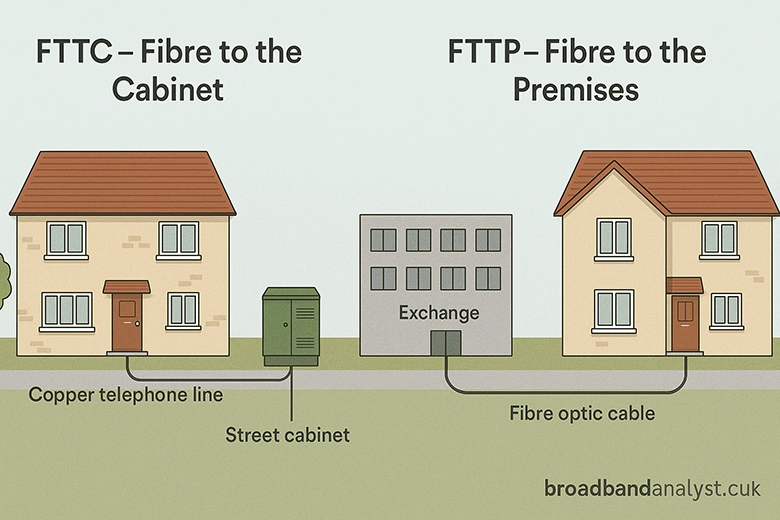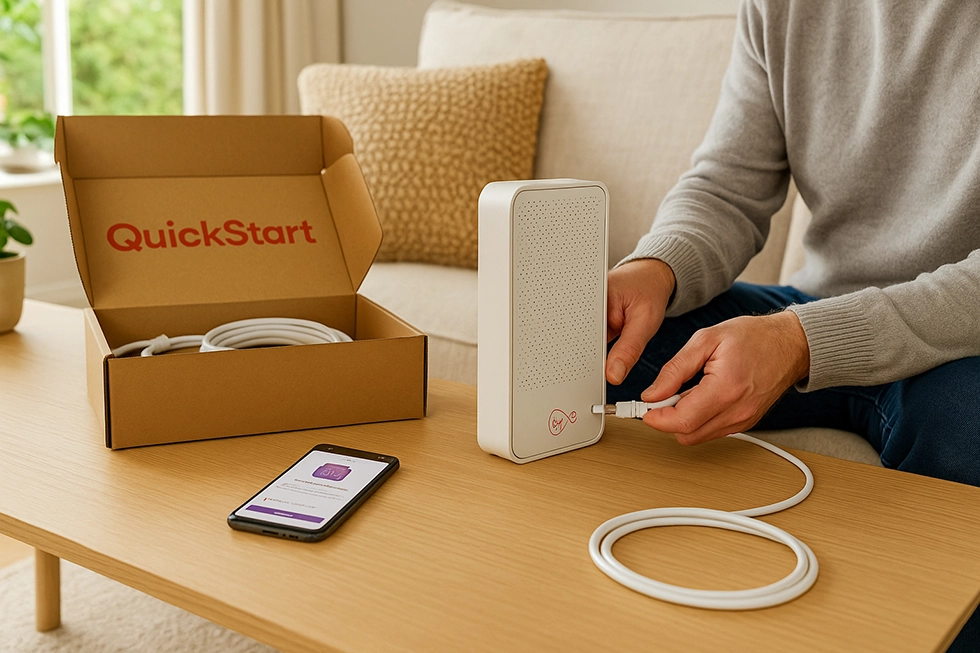Plusnet Full Fibre Review: 74 vs 145 vs 300 vs 500 vs 900
Plusnet has moved into ultrafast broadband with its full fibre packages. The provider offers five full fibre broadband plans with average download speeds of 74Mbps, 145Mbps, 300Mbps, 500Mbps, and 900Mbps.
Choosing the right plan comes down to what your household does online, how many devices are connected at once, and how much speed you actually need day to day.
This review takes you through how the plans compare on performance, setup, contracts, and overall value, making it easier to choose the one that matches your needs.
Plusnet Full Fibre Broadband – At a Glance
Plusnet’s Full Fibre broadband uses the Openreach FTTP network comes with following features:
- Delivered over Openreach’s FTTP network
- Broadband-only — no landline included or required
- Plusnet Hub Two router included
- 24 month minimum term contracts
- Unlimited data usage
- Subject to annual price increases (£4 flat rise every 31 March + 5% increase on any out-of-bundle charges)
- Reward cards included with special offers.
| Plan | Speed | Price | |
|---|---|---|---|
 Full Fibre 145 Full Fibre 14524 month contract |
145Mb avg |
£22.99 / month £275.88 / year More details |
 |
| FTTP. Free Setup. Includes £160 Reward Card. Offer ends 3rd December. | |||
 Full Fibre 500 Full Fibre 50024 month contract |
500Mb avg |
£28.99 / month £347.88 / year More details |
 |
| FTTP. Free Setup. Includes £190 Reward Card. Offer ends 3rd December. | |||
 Full Fibre 300 Full Fibre 30024 month contract |
300Mb avg |
£24.99 / month £299.88 / year More details |
 |
| FTTP. Free Setup. Includes £160 Reward Card. Offer ends 3rd December. | |||
 Full Fibre 900 Full Fibre 90024 month contract |
900Mb avg |
£31.99 / month £383.88 / year More details |
 |
| FTTP. Free Setup. Includes £190 Reward Card. Offer ends 3rd December. |
Enter your postcode to compare all deals
Pricing, Contracts and Reward Offers
All Plusnet Full Fibre plans come with a 24 month contract. There are no usage limits, and Plusnet doesn’t slow down your connection at busy times.
Prices depend on where you live and which deal you choose. Every March, Plusnet adds £4 a month to the broadband charge and increases any extras by 5%. This applies whether you’re a new customer, renewing your contract, or upgrading to a different plan.
You’ll need to pay by direct debit. If you decide to leave before the 24 months are up, there’s usually a fee based on how much time is left. The only exception is if you cancel during the cooling-off period or if installation can’t go ahead after a site check.
Some plans include a reward card if you sign up online. These are digital prepaid cards worth up to £100 that you can use like a gift card, and they’re sent by email after your broadband is up and running.
You’ll need to claim the card within two months of receiving the email. Once you’ve claimed it, you’ll have three months to activate it. The card is handled by a separate prepaid provider.
Overall, the prices are competitive for full fibre plans, and the reward cards add a bit of extra value to your broadband package.
Plusnet Full Fibre 74
Full Fibre 74 is Plusnet’s entry-level full fibre plan, offering average speeds of 74Mbps. It’s still quicker than most old fibre-to-the-cabinet lines and is suitable for homes with lighter day-to-day use.
This plan will comfortably support:
- HD streaming on 1–2 devices
- Video calls (Zoom, Teams, WhatsApp)
- Web browsing and email
- Music streaming
However, for homes with multiple 4K streaming devices, large game downloads, or several remote workers uploading large files, it may fall short. Upload speeds are also more limited than in higher-tier plans, which can affect cloud backups, video uploads, or gaming response times.
Best for: Individuals, couples, or households with fewer devices and limited simultaneous usage.
Plusnet Full Fibre 145
The 145Mbps plan strikes a balance between affordability and performance. It’s fast enough to support:
- Streaming in HD or 4K on multiple screens
- Smooth video calling on platforms like Zoom or Teams
- Console gaming
- Cloud services like Google Drive, iCloud, or Dropbox
Full Fibre 145 gives you more bandwidth than the 74Mbps plan, making it easier to keep things running smoothly when multiple people are online. It's a better fit for homes where children might be streaming shows or using apps on tablets while others are browsing or working.
The faster upload speed, averaging around 20Mbps, also handles video calls and everyday file sharing without issue.
This plan comfortably supports a moderate-sized household (2 - 4 users) with everyday internet demands.
Plusnet Full Fibre 300
With average speeds of 300Mbps, this plan offers enough speed for larger households with lots going on online. It’s suitable for:
- Streaming UHD (4K) content on multiple devices simultaneously
- Fast game downloads and updates
- Real-time cloud sync across laptops, phones, tablets
- Low-latency gaming
- Large household usage across 6–8+ devices at once
This plan works well for households where multiple users are active simultaneously — gaming, streaming, downloading or working from home. Compared to the 145 plan, it’s double the bandwidth, so network congestion becomes far less likely, especially during peak hours.
Best for busy homes with multiple devices, and households with gamers or regular media streaming.
Plusnet Full Fibre 500
The 500Mbps plan delivers ultrafast download speeds suitable for:
- Simultaneous 4K streaming on multiple TVs
- Multiple gamers using consoles or PCs
- Frequent file downloads >10GB
- Real-time online backups
- Smooth, high-quality video conferencing
For households with several heavy users, this plan offers the kind of bandwidth needed to keep everything running at once — whether that’s video calls, game downloads, or smart devices working in the background.
An average upload speed of 75Mbps provides enough bandwidth for those who upload large files, back up to the cloud, or manage media libraries online.
Best for: Large households, streamers, media-heavy professionals, or anyone needing a consistently reliable high-bandwidth connection across several rooms.
Plusnet Full Fibre 900
This is the top-end plan in Plusnet’s Full Fibre range, with average speeds around 900Mbps. It’s a solid option for households that either need that much capacity now or prefer to stay well ahead of future demands.
Full Fibre 900 is ideal for:
- High-bandwidth cloud workflows (e.g. real-time video collaboration, cloud editing)
- 4K/8K streaming across multiple screens
- Multiple simultaneous gaming sessions
- Large file transfers (e.g. creative professionals, media production)
- Upload speeds likely in the 100–120Mbps range (based on Openreach profiles)
That said, this plan is more than most households will ever need. For general browsing, streaming, or even occasional gaming, the connection won’t come close to being fully used. It’s better suited to homes with constant heavy usage — whether that’s multiple people working remotely, sharing large media files, or running cloud-based tools throughout the day.
Speed
| Plan | Avg. Download Speed | Avg. Upload Speed |
|---|---|---|
| Full Fibre 74 | 74Mbps | 20Mbps |
| Full Fibre 145 | 145Mbps | 30Mbps |
| Full Fibre 300 | 300Mbps | 50Mbps |
| Full Fibre 500 | 500Mbps | 75Mbps |
| Full Fibre 900 | 900Mbps | 115Mbps |
- At the lower end, Full Fibre 74 delivers average speeds of 74Mbps down and 20Mbps up.
- The mid-range plans, Full Fibre 145 and Full Fibre 300, come with 145Mbps/30Mbps and 300Mbps/50Mbps respectively.
- Full Fibre 500 offers 500Mbps down and 75Mbps up, while the flagship Full Fibre 900 comes with average speeds of 900Mbps downloads and 115Mbps uploads.
To put it simply, a 50GB game update could take around 90 minutes on Full Fibre 74, half an hour on Full Fibre 300, and less than 10 minutes on Full Fibre 900
For most households, 145Mbps or 300Mbps strikes the right balance of speed and value. The 500Mbps and 900Mbps tiers are best suited to either very demanding households or users with specific high-bandwidth needs.
Which Plusnet Full Fibre Plan Should You Choose?
If your usage is mostly browsing, email, or online shopping, any Plusnet Full Fibre plan will work reliably. Even the entry-level Full Fibre 74 can handle these tasks without issue.
But for activities like large downloads or uploads, HD or 4K streaming, cloud backups, and online gaming — or if your household has 10 or more connected devices or users — you may need a faster package like Full Fibre 300 or higher.
| Users | HD Streaming | Gaming | Suggested Plan |
|---|---|---|---|
| 1–3 | Regular | Occasionally | Full Fibre 74 |
| 1–5 | Regular | Occasionally | Full Fibre 145 |
| 1–5 | Regular | Regular | Full Fibre 300 |
| 1-7 | Regular | Regular | Full Fibre 500 |
| 7-15 | Regular | Regular | Full Fibre 900 |
FTTP vs FTTC – Why Plusnet Full Fibre Is Different
Plusnet’s Full Fibre packages use FTTP — Fibre to the Premises — which means the fibre-optic cable runs directly from the exchange to your home. This end-to-end fibre connection removes the copper bottlenecks found in older broadband technologies.

In contrast, FTTC — Fibre to the Cabinet — only brings fibre to a street cabinet nearby, with the final stretch to your property relying on copper telephone lines. That last section often limits speed, particularly for homes further away from the cabinet.
FTTP delivers more reliable download and upload speeds. It also provides lower latency and maintains consistent speeds, especially during evenings when many users are online. There’s no need for a phone line, and speeds remain stable regardless of your location within the network.
For homes with several users streaming, working remotely, or gaming at the same time, FTTP offers a much more stable connection than FTTC.
Plusnet Hub Two
Plusnet Full Fibre plans come with the Hub Two router included at no extra cost. It’s a basic, reliable router that’s designed to work straight out of the box with a full fibre (FTTP) setup.

The Hub Two supports dual-band Wi-Fi, which means it can broadcast on both 2.4GHz and 5GHz frequencies — useful for balancing range and speed depending on where your devices are in the house. It also includes four Ethernet ports, so you can plug in devices like smart TVs, game consoles, or laptops directly if you prefer a wired connection. The LAN ports support gigabit speeds, so you won’t be limited when connecting directly over Ethernet.
Setting it up is straightforward. Once the Openreach engineer installs the ONT (Optical Network Terminal), you simply connect the Hub Two to it using the Ethernet cable provided, plug it in, and you’re ready to go.
The router also includes a built-in firewall and simple parental control features, which let you block certain types of content or restrict access by device. These features aren’t as advanced as what you’d get with more expensive third-party routers, but for most households, they’ll cover the basics.
That said, the Hub Two isn’t a high-end router. In flats and smaller houses, it usually performs well, but in larger homes — especially those with thick walls or multiple floors — the Wi-Fi signal may not reach every corner. If you’ve got lots of smart devices or want better coverage in distant rooms, you may need extra equipment like a mesh system or booster if the signal doesn’t reach every room.
Setup and Installation Process
When you sign up for Plusnet Full Fibre, an Openreach engineer will visit your home to carry out the installation. This is necessary because Full Fibre (FTTP) needs a new connection that runs directly into your property.
The engineer will start by mounting a small box on the outside wall of your home. This is where the fibre cable from the street enters your building. From there, they’ll drill a hole through the wall to feed the cable inside.
Inside your home, the engineer will install a device called an ONT — that stands for Optical Network Terminal. It needs to be placed near a double power socket and in a spot where you plan to keep your router. Once that’s set up, the Hub Two router is connected to the ONT using an Ethernet cable.
After everything is wired up, the engineer will power on the equipment and test the connection to make sure it’s live. They’ll usually check it using one of your own devices, like a phone or laptop, to confirm everything’s working as expected.
The whole process normally takes between one and three hours. If your property needs a more detailed check beforehand — for example, if the route for the cable isn’t straightforward — Plusnet or Openreach will contact you to arrange a survey.
If the engineer finds that extra work is needed, you’ll be told what’s involved and how long it might take. You’re not locked in at this stage — if you decide not to go ahead with the installation after the survey, you can cancel the order without any charges.
Mobile & Extras
Plusnet is owned by BT Group, which also owns EE. Because of that, some Plusnet broadband customers may be offered extra deals through EE, especially on mobile plans. These are usually SIM-only deals that come at discounted prices and are only available to existing customers. If you’re already thinking about switching your mobile network or want a better deal for your phone, these offers might be worth looking into.
As part of EE promotions, there’s sometimes a six-month free trial of Apple Music included with mobile plans. This won’t affect your broadband service, but it’s an added perk if you use music streaming regularly.
On the broadband side, Plusnet includes a basic content filter called Plusnet Safeguard. It lets you block certain websites or categories of content, which can be useful for families with younger children. It’s easy to set up through your account settings.
For users who want added online protection, there’s also an optional security package called Plusnet Protect. It’s powered by Norton and can help guard against malware, viruses, and phishing. This isn’t included by default on all plans and may come with an extra charge, depending on the package.
None of these extras change how fast or reliable your broadband is, but they might make a difference if you’re looking for an all-in-one setup that covers mobile, security, and family use alongside your internet connection.
Losing Your Landline – What You Should Know
When you move to any of Plusnet’s Full Fibre plans, you’re switching to a broadband-only connection. That means there’s no landline included, and your home phone number will be disconnected. Once the switch is made, you won’t be able to make or receive calls over the landline anymore.
This also means you won’t be able to call emergency services like 999 or 112 using your home phone. If you’ve been relying on a landline to make emergency calls, that option won’t be available after the upgrade to Full Fibre.
It’s important to know that any devices in your home that depend on a phone line will also stop working. This includes things like personal alarms, fall detectors, emergency call buttons, and other telecare equipment that connects through your landline. Security systems or monitored alarms that use a phone line for alerts may also be affected.
If you have any of these devices in use, or if you’re unsure whether something in your home needs a landline to function, it’s best to speak to Plusnet before you switch. They can help check what your options are or point you towards a suitable digital alternative.
Customer Service
Customer service has always been a deciding factor when choosing a broadband provider, and Plusnet performs strongly in the latest independent reports.
According to Ofcom’s Q1 2025 Complaints Report (published 7 August 2025), Plusnet generated the fewest broadband complaints of any major UK provider. It recorded just 5 complaints per 100,000 customers, half the industry average of 10. On the landline side, complaints were also below average at 3 per 100,000 customers compared with an industry average of 5.
The Ofcom Customer Service Report (May 2025) highlights similar strengths. Plusnet customers reported higher-than-average satisfaction levels for both broadband (91%) and landline (83%) services. Only 17% of customers said they had a reason to complain in 2024, below the overall market figure of 23%. This compares favourably against rivals such as Virgin Media and Sky, where more than a quarter of customers said they had reason to complain.
Fault handling is another area where Plusnet stands out. It had the lowest proportion of repeat total-loss-of-service faults, at just 2%, showing that issues are more often resolved the first time. In terms of complaint handling, 65% of Plusnet customers were satisfied with how their case was managed, above the sector average of 58%.
While Ofcom’s independent data reflects well on Plusnet, customer reviews elsewhere are more mixed. On Trustpilot, Plusnet has 11,769 reviews with a TrustScore of 1.9 out of 5. The most common complaints mention delays, billing issues, or inconsistent communication, while positive reviews tend to highlight helpful staff once contact is made.
Additional survey data from Which? shows Plusnet achieving a 73% customer score, earning it recognition as a recommended provider.
Pros and Cons of Plusnet Full Fibre
Pros
- Full FTTP technology (no copper).
- Wide range of speed tiers.
- Hub Two router included.
- Unlimited usage.
- EE mobile extras and reward cards.
Cons
- 24-month contracts only.
- Annual price rises.
- No landline service.
- Availability still limited in rural areas.
- Installation may involve surveys or delays.
Is Plusnet Full Fibre any good?
Plusnet Full Fibre brings fast, stable broadband into homes using FTTP technology. All plans benefit from the same network reliability, same hardware, and same support — the difference lies in how much speed you truly need.
If you're upgrading from older ADSL or FTTC, even Full Fibre 74 will feel significantly faster. But as more devices demand more bandwidth — from smart TVs and gaming consoles to work-from-home apps — it makes sense to go higher if your budget allows.
Ultimately, Plusnet’s Full Fibre range is one of the more straightforward FTTP offerings in the UK — with clear speed tiers, a single router type, and installation backed by Openreach.


